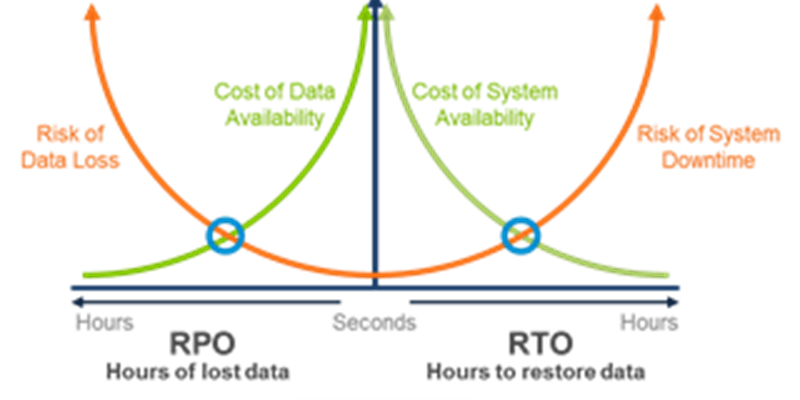The Three C’s of Data Protection
When searching for the best solution for backing up your data, it doesn’t matter whether you are a Fortune 50, Fortune 500 or a small to mid-size organization. What does matter is whether you can find the ideal solution to meet your specific requirements.
What I have traditionally found is that backup/recovery requirements (regardless of company size) generally fall into three categories:
- Cost
- Complexity
- Capability
Of course there are many requirements beyond just three, but I would suggest that each and every one of them will fall under one of these three. Before we chat about each of these in a little more detail, let’s assume that you’ve done your due diligence and identified all your requirements…things like Recovery Time Objectives (RTO), Recovery Point Objectives (RPO), Version Retention Objectives (VRO), Geographic Redundancy Objectives (GRO), and any others that are specific to your organization. Let's further assume that you've identified these requirements across all the impacted business units by engaging the respective stakeholders. Now let's look at the C's a little closer.
Cost
Some say that cost is everything when investing in new technology. Arguably, cost is a critical factor, but shouldn’t be the one and only criteria when looking to safely protect your data. As you vet potential solutions, consider the following:
- It’s likely that as your data protection requirements increase, so too will the cost of the solution. Using RTO and RPO in the following example, you will see that as RTO and RPO requirements tighten closer to zero, the cost increases at a rate of diminishing returns.
- The ideal solution in this case meets or exceeds RPO/RTO requirements for a cost that does not exceed the value of the assets nor the cost of downtime, which typically is identified at the intersection of risk and cost. This intersection will likely vary across business units and/or applications so it would be wise to identify business stakeholders and solicit input from them.
Similar analyses can be performed on your GRO and VRO. The more protection you need, the more costly it becomes. I've seen time and time again where a business stakeholder says something like, "I need everything backed up every night, two copies, and I need to recovery ANYTHING from any point in time." Feasible? Perhaps. Cost effective? Most likely not. Remember that solving your backup problem is a balancing act between real needs and real budget.
Complexity
When you became an IT expert, I bet you weren’t dreaming that you’d be spending 75% of your time maintaining your current environment. I sure wasn’t. And to make matters worse, as your company is evolving you are asked to perform more and more with tools that were good "back then" but are now old and outdated. I bet you have been in the situation where you hope that nothing will “happen” when you have to make a change to the existing infrastructure. Bottom line, your company is evolving to stay current but your environment prevents you from keeping pace. The majority of your time is spent maintaining legacy applications and hardware instead of innovating along with your company.
One great way to begin changing this paradigm is to reduce the complexity of your infrastructure. Sure, you have reduced some complexity with virtualization and other technologies, but have you done anything to reduce the complexity of your backup?
By nature, your backup infrastructure can be complex simply because of the different requirements put upon you from different business stakeholders. Ironically, in order to innovate, you need to reduce complexity. To protect your data properly, you need to identify all the various requirements across business units, which ultimately adds to the overall complexity. A true Catch-22 it seems. The good news is that this can change.
Knowing that one size doesn’t fit all, consider finding a vendor that promotes a unified approach to meet different backup and recovery requirements using open standards. Try to eliminate multiple point products and multiple vendors. Multiple vendors/products reduce flexibility and limit integration which creates...wait for it...more complexity. Hmmm…so…reduce complexity by incorporating another level of complexity? This sounds like a different Catch-22! Sound advise leans toward identifying and incorporating the fewest components in whatever you do to meet your needs.
Capabilities
As you innovate, you will quickly see the need to find a solution that can evolve along with you. It is important to identify a solution that meets your current needs, but also is flexible and adaptable as you innovate and modify your infrastructure. For example, a Purpose Built Backup Appliance (PBBA) may address a current requirement of reducing the storage footprint for your backup data. Nice, but you may also have a long term goal to reduce costs by utilizing the cloud. A good solution should easily be able to address these changes as seamlessly as possible.
Other backup capabilities to consider include:
-
Optimize resource utilization by:
- Minimizing your storage footprint, which can increase your retention cycle
- Avoiding use of your network for backup traffic
- Integrating with critical workloads
-
Obtain Service Level Objectives by:
- Meeting your ever-changing backup window
- Meeting current and future RTO/RPO requirements
- Optimizing your retention policies
- Incorporating backup into a larger business continuity/disaster recovery strategy
-
Ensure data is consistent, secure and recoverable by:
- Performing validation checks on file system and/or application-specific backup data
- Encrypting data that meets DoD standards
- Moving data across physical servers, virtual servers and the cloud.
Now what?
You've identified your requirements. You're feeling good. You're ready to innovate. So now what? I suggest start by looking at the Quest portfolio of data protection products. Then reach out to your sales team for an in-depth discussion. I promise they don't bite.
We would love to discuss YOUR backup needs and how Quest can address YOUR three C’s of data protection.
Take YOUR valuable time back so you can INNOVATE! We can help!






